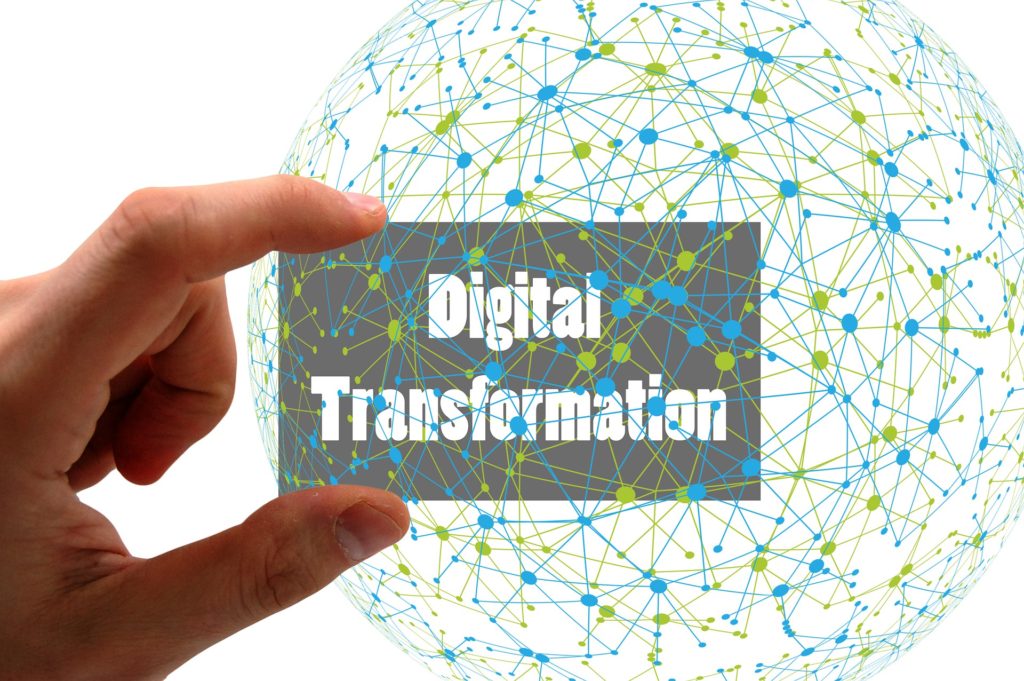Digital Transformation: A Simple Explanation Without Unnecessary Hype
Gone are the days when a typical business in the 90s would employ box-like computers, struggling to stuff data into terribly small storage devices. Gone are the days when the customers would need to be patient while transacting online . Today, we are on the information highway. All our tasks and needs are now handled online fully or at least, partially. Businesses, especially those relying on Information Technology, are now employing cutting-edge technologies every day to handle exponentially increasing user-requests, user-data, overall transactions and to make their customer service smoother with their own apps and websites. No longer do customers wait too long for new updates to the products and for bug fixes. These now happen within a specified time frame and that too without any frustrations! This revolutionary usage of digital technologies using automation and AI is what we call digital transformation.

However, businesses did not achieve this fast and smooth software development and IT process with the wave of a magic wand. Let’s dive deeper and first get a picture of what it was like before this digital transformation.
The History: What It Was Like Before Digital Transformation Made An Entry
Before this digital transformation, a developer or a developer team would build a software solution or add new codes to the existing process. Then, after testing (on the developer’s machine), the code would be handed over to the operations team. The operations team would find some bugs while deploying the code in the real environment where the code would be. We no longer have that old blame game.
The Waterfall Model
Back in the 80s and 90s and in some cases even today, the software development process was linear. There were defined steps that followed one after another- like a waterfall. The steps essentially included Pre Development planning, Development, Integration of different units of the software, testing the built software, and then implementation in the real-life scenario. This development process was too rigid and did not allow overlapping of steps. Nor did it allow any room for modification during the development process in case the requirement of the client changed.
The Agile Model: The Precursor To Digital Transformation
To overcome the challenges involved in the Waterfall Model, developers and operations teams started employing the agile delivery process. In this process coding and testing happens at the same time. There is room for modification of the code early in the development cycle. This means customers can change their requirements with no frustration whatsoever. With continuous testing happening during each iteration, there is little chance of bugs creeping into the finished software.
From Agile To DevOps
While the agile model made the software development process smoother, the operations team was still in the dark ages. They were still following the waterfall model. And the lack of synchronization between the developers and the operations made the deployment process quite a headache. If there is a lack of communication between the two teams, problems like new codes being incompatible with the older functions, codes that need more hardware power than the operations team imagined, etc. So to overcome these problems, businesses today are merging the developer team and the Operations into one entity.
The mashup of “Development” and “Operations” is what we call DevOps
DevOps Features
DevOps brought with it a whole new model of the software development process:
- CD or Continuous Development: Unlike the previous models, in DevOps culture, a software solution is not updated as a whole. Developers break it into small chunks. Then these chunks are updated as and when required.
- CI or Continuous Integration: With the help of automation, the updated aspect of the software is then integrated into a central database where the software is run to see if any problem arises.
- Continuous Testing: Unlike previous models, in this paradigm, the developers can test the new codes early in the development process. This saves time and budget.
- Continuous Deployment: Automation is the keyword in DevOps. Sometimes, the updated piece of the software is passed on to the production department without any human intervention.
- Continuous Delivery: Sometimes, the new code waits for the human nod to pass on to the production environment.
- Continuous Monitoring: Tools like Kibana and ElasticSearch, etc help DevOps team to monitor the updated software until the last step in automated ways. This makes the deployment journey smoother.
- Continuous Feedback: Since in DevOps culture, modifying a new code is not a cumbersome process, the DevOps team does not shy away from taking feedback.
- Continuous Optimization: With the feedback, the DevOps team can further optimize the software without much fuss as everything is DevOps automates everything.
The Role of Jenkins in CI/CD pipeline
DevOps focuses on automation. So the updated software that is sent to the central repository is first compiled. Then the developers test it with Jenkins – an open-source tool for continuous integration. If the tests and compilation by Jenkins prove to be successful, the team sends the code to Production. If the code fails to compile, the developer fixes it and then again commits it to the repository.
Docker
Even the DevOps process is not free of hiccups. The operations team works with tools such as Ansible, Puppet or Chef which the developers are not familiar with. On the other hand, the developers are the ones to know the nitty-gritty of the software or software iterations. Hence, deploying updated software proves to be problematic. Again, sometimes the updated software would work well on the system of the developers but would fail to work in the real environment.
Containers and Kubernetes solve these two problems. A container contains applications and their dependencies in such a way that the application can work independently without relying on the operating system. Docker is the most famous container program. Docker solves two problems:
- Since the runtime environment is provided by Docker, the application would run in the same way as it ran in front of the developers.
- While developing in testing, the updated version of the software is dockerized in a new Docker container. If any problem arises, you can easily reinstate the old Docker container.
Kubernetes
But since we are talking about enterprise-level containers, the developers need to employ too many of these Docker containers. So, to manage these containers, developers use the tool called Kubernetes.
The era of simplification ushered in by the DevOps culture is further glorified by the use of Kubernetes. These are the reasons why the developers and the IT world consider Kubernetes revolutionary –
- Simplification – Dealing with too many containers could have been an uphill task if there were no Kubernetes. Kubernetes greatly simplifies the task of container management.
- Always-on Software and Websites – With the help of Kubernetes, the DevOps team can deploy the replicas of the if they any error results in their deletion or malfunction.
- Auto-Scaling – The power of creating replicas of the containers is with Kubernetes. With the help of Kubernetes, a company can increase the number of pods or groups of containers if there is an excess in demand. Again, if there is an excess in resource consumption, Kubernetes can reduce the number of pod replicas. Thus balancing budget and demand is now devoid of frustration.
The Era of Abstractions: Cloud Computing, SaaS, IaaS, PaaS and Beyond
As the world was seeing the rise of automation, another revolution was underway. Cloud Computing became a norm. The pundits will tell you that cloud computing has been here since the 1960s. But it came into existence in its true sense just a decade ago.
So what is cloud computing? As the name suggests, cloud computing is the name given for the computation happening in the cloud. What is cloud? It is the server or the data centre that you can access via the internet. So you don’t need to own a physical server. Ofcourse this is a very basic definition. But this will do for now.
There three major aspects of cloud computing –
- Infrastructure as a Service
- Platform as a Service
- Software as a Service
There are many great articles on the difference between these 3 aspects. We won’t repeat that. Let’s give you an Eli5 ( Explain Like I’m 5) version of these 3 modules of cloud computing.
Simple Explanation Of SaaS, PaaS and IaaS
Suppose you want to make a Netflix-like movie streaming web app. For that, you need three things –
- The program to build the streaming software
- The necessary tools to build the software from the code or program.
- The movies (read data) stored in the data centres – to be played on demand.
Now keeping this example in mind let’s analyse –
Infrastructure as a Service –
When you build the software on your computer but then you use the remote data centres – away from YOUR location – to deploy the software and to store the movies (data).
Platform as a Service –
When you can use the tools (necessary to build the software) online. So you don’t need to tinker with dockers or Kubernetes on your physical hardware – they are managed by the cloud service provider.
Software as a Service –
In this case, you don’t make the software at all. Somebody else on the internet makes it for you. You can get a license to use it ( Online ofcourse). You can even resell the product.
These days, the border between IaaS and PaaS is getting blurred.
Cloud Computing marks the summit of this mountain called Digital Transformation.
It seems as if there is nothing more to achieve.
However this is just the beginning.
There is a lot more to be achieved by digital transformation.
And the sky’s the limit.





